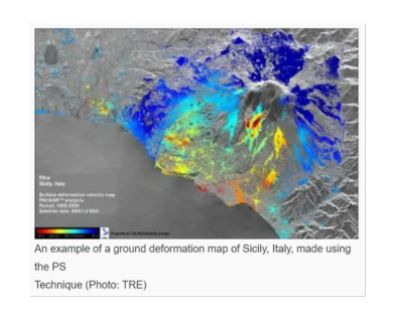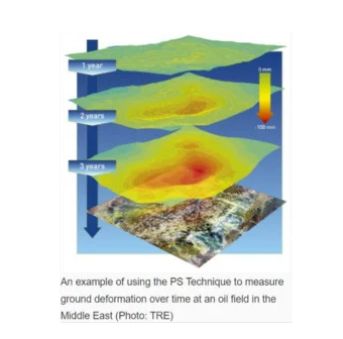- with readers working within the Construction & Engineering industries
Gone are the days in which opportunities to participate in the space race were reserved for a select few. Considerable private sector investment in space-related technological innovation has led to unprecedented levels of access to space for organisations of all shapes and sizes.
One such technological innovation involves the development, launch and operation of satellites into orbit around the Earth for the purposes of collecting all kinds of data. The spread of this practice in years previous is due, in part, to a considerable reduction in the costs associated with the development, launch and operation of these satellites. With costs reduced, access to space becomes available to so many more organisations than was previously the case, with space-related technological innovation becoming a viable option for increased commercial success.
The number of possible scenarios in which the collection of data by satellites in space proves beneficial is, quite frankly, astonishing. For example, continuing with the trend of unlikely space racers, Coca-Cola have in the past few years joined the fray. Satellite data company OneWeb, which had, as of 2017, generated $1.2 billion worth of investment, could credit Coca-Cola as one of its seven investors. Coca-Cola were keen to use data collected by OneWeb's satellite network to help manage some of their more remote, inaccessible locations, as regards internet access and supply chain management.
Moving on from the soft drink industry, the collection of data by satellites in orbit around the Earth also provides vital support to those responsible for growing the food we eat. By monitoring stages of crop growth from space, and relaying the emergent data to agricultural organisations back on Earth, these satellites are capable of better informing the agricultural process, and even of projecting the growth rate of certain crops. The monitoring of groundwater reserves (water present underground) by similar satellites in the US has also provided detailed insights as to exactly how much of this water is available. As a proportion of these reserves is put to use in order to fuel crop growth in the US, agricultural capabilities are further enhanced.
So far, therefore, we've had Coca-Cola accessing space, and farmers too... Who else?
Yes, you guessed it – real estate agents. Data collected by satellites orbiting the Earth, and relayed back to organisations on the ground, enables the detection of sinkholes beneath particular residential areas. The data can also be used to predict the likelihood of a sinkhole developing under a certain residential area as the years progress, as well as any detrimental effects which rises in the global water level might have. It follows that this data can also be used in determining real estate prices.
As another example of the diverse applicability of satellite data, technological innovations have enabled the collection of data concerning human behaviour here on Earth.
By mapping foot traffic patterns in and around retail outlets, and even the number of cars parked in the car park of a certain retail outlet over an extended period of time, satellites have been proven to produce data which serves as a relatively accurate indicator of fluctuations in the stock price of the retail outlet concerned – information vitally important to any potential investor, as well as to the retail outlet itself.
Data providing insights as to human movement and traffic patterns is also extremely useful in the development of urban areas as the years progress, and the human population continues to expand.
The above examples stand as testament to the importance of data collected by satellites in orbit around the Earth, and are by no means exhaustive. As a matter of fact, just last week, the first data maps produced using data collected by the very first "space-based instrument designed to continuously measure air quality over North America with the resolution of a few square miles" were released by NASA. By releasing these maps which provide details as to the levels of nitrogen dioxide – generally produced via the burning of fossil fuels – above major urban areas throughout the US, the US government are aiming to enable individuals across the country to remain informed as to the quality of the air they breathe via the publication of data collected by a space-based instrument – a light analyser known as the Tropospheric Emissions: Monitoring of Pollution (TEMPO). Once again, the improvement of the lives of individuals on the surface of the Earth is made possible by the collection of data far, far above their heads.
Of course, any private sector investment in the collection of data in space must be well informed as to the related intellectual property rights. The investment process involves scrutiny of any innovator's intellectual property portfolio, so as to ensure that, upon the receipt of investment, only that innovator is entitled to exploit the technological innovation in question. As such, the intellectual property protection for any technologies which enable the collection of data in space is vital to ensure the continued investment in the industry, and the continued benefit of any data collected to individuals, businesses and societies alike.
In fact, the journey of Politecnico di Milano's first ever spin-off organisation, from conception to global success, is inextricably bound to the university's astute handling of the intellectual property concerns which arose throughout.
In 1985, members of staff at the university were conducting investigations into the potential use of data collected via Synthetic Aperture Radar ("SAR") satellites in order to generate surface maps showing measurements of ground deformation on the Earth's surface. Such investigations led to the development of the PS Technique – a unique tool for the detection, measurement and monitoring of different geophysical phenomena (e.g. subsidence, landslides, seismic faults), and the verification of the structural stability of individual structures. In other words, the PS Technique provides precise measurements of ground displacements with use of SAR data collected by sensors mounted on satellites in orbit around the Earth.

In 1999, having developed the PS Technique, Politecnico di Milano began the process of acquiring intellectual property protection in the form of patent applications for the protection of the PS Technique in multiple jurisdictions the world over – including Canadian, European, Japanese and US patent applications. Furthermore, the university decided to create its first ever spin-off company – Tele-Rilevemento Europa (TRE). TRE became the exclusive licensee of each of the patents granted for the PS Technique, and thus the only entity in the world authorised to apply the technique.
As such, TRE came to serve as a devoted channel through which the university could exploit the PS Technique patents effectively, with the inventors themselves also receiving financial incentives in the form of patent royalties and the income generated by TRE itself. As such, the university – via TRE – was able to make practical use of the technology in question, all the while generating important additional funds for the university to exploit.

Today, from a university research group, TRE has progressed considerably to become the largest organisation specialising in SAR data processing activities worldwide. Due to the high degree of novelty of the PS Technique – protected securely by means of TRE's wide-ranging patent portfolio – TRE enjoys the commercial benefits of having no direct competitors. The organisation has grown to work with clientele all across the globe, including European municipal governments to international corporations and organisations.
In summary, recent reductions in the costs associated with the collection of data in space have led to surges in the levels of investment in the production of enabling technologies, the applicability of which is astonishingly wide-ranging and diverse. Such applications provide benefits to individuals, organisations and societies alike, increasing qualities of life and levels of commercial success. As such, it appears to be in the best interests of all of us here, on the surface of the Earth, that this industry continues to flourish. It also appears evident that, in order to ensure such continued growth, the astute protection of any intellectual property rights arising throughout the processes of technological innovation in this field is vital. In protecting any such intellectual property rights accordingly, the heights of commercial success which innovators can reach become ever higher.
Sources
- Space Exploration Innovation Brought to Earth
- NASA releases first U.S pollution map images
- Successful Technology Transfer through a Spin-off Company
The content of this article is intended to provide a general guide to the subject matter. Specialist advice should be sought about your specific circumstances.



